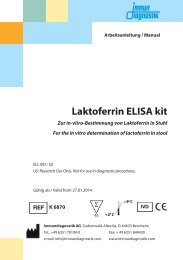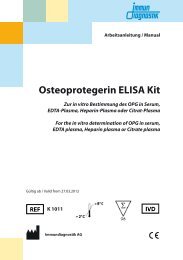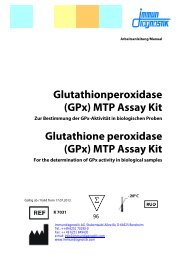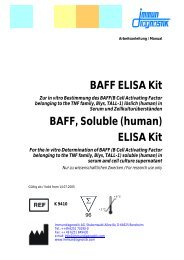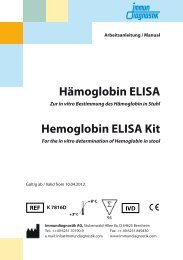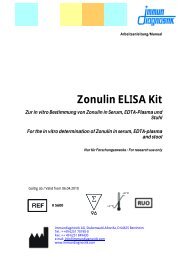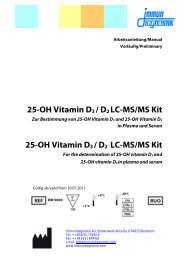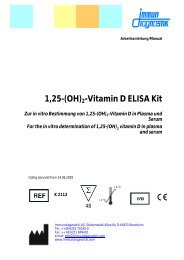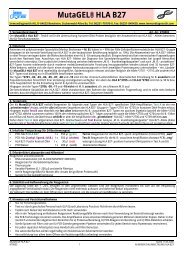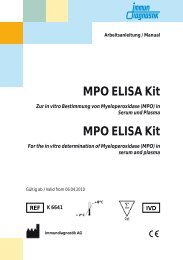MutaREX ® Enterovirus real time - bei Immundiagnostik
MutaREX ® Enterovirus real time - bei Immundiagnostik
MutaREX ® Enterovirus real time - bei Immundiagnostik
Erfolgreiche ePaper selbst erstellen
Machen Sie aus Ihren PDF Publikationen ein blätterbares Flipbook mit unserer einzigartigen Google optimierten e-Paper Software.
<strong>MutaREX</strong> <strong>®</strong><br />
<strong>Enterovirus</strong><br />
<strong>real</strong> <strong>time</strong> RT-PCR Kit<br />
Screening Test für den Nachweis humaner <strong>Enterovirus</strong> RNA (Polio-,<br />
Coxsackie A-, Coxsackie B- und Echoviren) im <strong>real</strong> <strong>time</strong> PCR Kapillarsystem<br />
(z.B. LightCycler <strong>®</strong> , Roche) und gleichzeitiger Überprüfung der<br />
RNA-Extraktionseffizienz aus Stuhlproben.<br />
KG290232<br />
KG290296<br />
Nur für in vitro Diagnostik<br />
<strong>Immundiagnostik</strong> AG, Stubenwald-Allee 8a, 64625 Bensheim, Germany<br />
www.immundiagnostik.com Tel.: +49 (0)6251/ 701900<br />
info@immundiagnostik.com Fax: +49 (0)6251/ 849430<br />
Stand: 23.09.2010 1<br />
N:WINDAT/AL/MB/K/MRex
1. VERWENDUNGSZWECK<br />
Der <strong>MutaREX</strong> <strong>®</strong> <strong>Enterovirus</strong> <strong>real</strong> <strong>time</strong> RT-PCR Kit ist ein qualitativer Screening-Test zum<br />
Nachweis von <strong>Enterovirus</strong> RNA (Polio-, Coxsackie A-, Coxsackie B- und Echoviren) in klinischen<br />
Proben (Vollblut, Plasma, Respirationstraktproben, CSF (cerebrospinal fluid) und anderen Körperflüssigkeiten)<br />
mittels <strong>real</strong> <strong>time</strong> PCR-Kapillarsystem (z. B. LightCycler <strong>®</strong> (Roche). Gleichzeitig ist<br />
eine Überprüfung der RNA-Extraktionseffizienz über eine separate interne PCR-Kontrolle möglich.<br />
2. EINLEITUNG<br />
Humane Enteroviren sind ubiquitär vorkommende, hochinfektiöse Krankheitserreger, die zur<br />
Familie der Picornaviridae gehören. Die mit hoher Inzidenz (weltweit ca. 500 Millionen Infektionen/<br />
Jahr) vorkommenden Pathogene sind kleine unbehüllte RNA-Viren, die sehr resistent gegenüber<br />
Umwelteinflüssen sind. So behalten Enteroviren selbst <strong>bei</strong> pH-Werten 3 – 9 sowie in Anwesenheit<br />
von Detergenzien ihre Infektiosität. Bislang sind ca. 70 verschiedene Serotypen beschrieben aber<br />
kein effektives antivirales Chemotherapeutikum zur Bekämpfung der Viren ist verfügbar. Die<br />
Übertragung der Viren erfolgt von Mensch zu Mensch fäkal-oral , d.h. ausschließlich über Kontakt-<br />
und Schmierinfektion. Kontaminierte Lebensmittel/ Trink-wasser stellen da<strong>bei</strong> eine wichtige<br />
Infektionsquelle dar. Das Virus kann noch über Wochen nach der akuten Erkrankung mit dem<br />
Stuhl ausgeschieden werden.<br />
<strong>Enterovirus</strong>infektionen können das ganze Jahr über auftreten und lebensbedrohende Infektionen<br />
hervorrufen (insbesondere <strong>bei</strong> Kindern). Im Sommer kommt es in Deutschland zu Häufungen der<br />
Infektionen aufgrund kontaminierter Badegewässer (Schwimmbad, See). Enteroviren lösen<br />
zahlreiche Krankheitsbilder aus, z. B. Infektionen des oberen Respirations-trakts, „Sommergrippe“,<br />
Herpangina, Hand-Fuß-Mund-Krankheit, jugendlicher Diabetes mellitus, Infektionen des Gastrointestinaltrakts,<br />
Augeninfektionen, oder epidemische Myalgie. Aber auch Myocarditis, Paralysis,<br />
multiples Organversagen, Meningitis und Encephalitis sind häufig mit einer <strong>Enterovirus</strong>infektionen<br />
assoziiert.<br />
3. TESTPRINZIP<br />
<strong>MutaREX</strong> <strong>®</strong> <strong>Enterovirus</strong> <strong>real</strong> <strong>time</strong> RT-PCR enthält spezifische Primer, Hydrolysis-Sonden und<br />
weitere Reagenzien zur Detektion von <strong>Enterovirus</strong> RNA in klinischen Proben im LightCycler <strong>®</strong> -<br />
Instrument (Roche). Zielsequenz ist innerhalb der 5`-untranslatierten Genomregion (5`-UTR).<br />
Die im Kit enthaltene reverse Transkriptase schreibt das virale ssRNA-Genom in cDNA um und<br />
eine thermostabile DNA-Polymerase amplifiziert mittels PCR (polymerase chain reaction) ein<br />
enterovirusspezifisches DNA-Fragment. Nachfolgend wird die Spezifität des entstandenen<br />
Amplikons durch <strong>real</strong> <strong>time</strong> Hybridisierung und anschließende Hydrolyse der <strong>Enterovirus</strong>-<br />
spezifischen Sonden (mit Fluorophor- und Quenchermolekül markierte Oligonukleotide) überprüft.<br />
Das da<strong>bei</strong> emittierte Fluoreszenssignal wird von der optischen Einheit des <strong>real</strong> <strong>time</strong> PCR-<br />
Kapillarsystems (z. B. Light Cycler <strong>®</strong> , Roche) gemessen. Die Detektion spezifischer <strong>Enterovirus</strong>-<br />
Amplifikate in den <strong>real</strong> <strong>time</strong> PCR-Reaktionsgefäßen erfolgt <strong>bei</strong> 530 nm (z. B. LightCycler <strong>®</strong><br />
Fluorimeter-Kanal F1).<br />
Zusätzlich verfügt <strong>MutaREX</strong> <strong>®</strong> <strong>Enterovirus</strong> über eine separate RNA-Extraktionskontrolle, die vor<br />
der eigentlichen Nukleinsäureisolierung dem Ausgangsmaterial zugefügt und dann in einem<br />
zweiten heterologen Amplifikationssystem nachgewiesen wird.<br />
Diese interne Kontrollreaktion (IC) ermöglicht zum einen das Aufdecken von Fehlern <strong>bei</strong> der RNA-<br />
Extraktion, zum andern kann eine mögliche Inhibition der Reversen Transkription bzw. PCR<br />
identifiziert werden. Das Risiko Falsch-Negativer Ergebnisse wird dadurch deutlich minimiert.<br />
Die Detektion der RNA-Extraktionskontrolle (= interne Kontrolle für die PCR) wird <strong>bei</strong> 705 nm<br />
durchgeführt (z.B. LightCycler <strong>®</strong> Fluorimeter-Kanal F3 <strong>bei</strong> 1.5 bzw. F6 <strong>bei</strong> 2.0).<br />
Stand: 23.09.2010 2<br />
N:WINDAT/AL/MB/K/MRex
4. KITBESTANDTEILE<br />
Jedes Testkit enthält Reagenzien zur Durchführung von 32 bzw. 96 Bestimmungen, sowie<br />
eine Gebrauchsanleitung.<br />
Ref. Reagenz Konfektion 32 Konfektion 96 Deckelfarbe<br />
A1<br />
A2<br />
A3<br />
A4<br />
A5<br />
Enzym-Mix<br />
Primer-/ Sonden-Mix<br />
Positivkontrolle<br />
Negativkontrolle<br />
Extraktionskontrolle<br />
1x 30 µl<br />
1x 500 µl<br />
1x 30 µl<br />
1x 200 µl<br />
1x 200 µl<br />
3x 30 µl<br />
3x 500 µl<br />
2x 30 µl<br />
1x 200 µl<br />
3x 200 µl<br />
5. ERFORDERLICHE LABORGERÄTE UND HILFSMITTEL<br />
Benötigte Materialien - mitgeliefert:<br />
• Reagenzien für die <strong>real</strong> <strong>time</strong> RT-PCR<br />
• Gebrauchsanweisung<br />
Stand: 23.09.2010 3<br />
N:WINDAT/AL/MB/K/MRex<br />
blau<br />
gelb<br />
rot<br />
grün<br />
transparent<br />
Benötigte Materialien - nicht mitgeliefert:<br />
• <strong>real</strong> <strong>time</strong> PCR-Kapillarsystem (z. B. LightCycler <strong>®</strong> Instrument, Roche)<br />
• PCR-Reaktionsgefäße (z. B. LightCycler <strong>®</strong> Kapillaren, Roche)<br />
• Tischzentrifuge (z. B. LightCycler <strong>®</strong> Kapillar-Zentrifuge, Roche)<br />
• Kryobehälter für PCR-Reaktionsgefäße (z.B. LightCycler <strong>®</strong> Cooling Block, Roche)<br />
• Color Compensation Kit (z. B. LightCycler <strong>®</strong> - Roche)<br />
• RNA-Extraktionskit für Stuhlproben (z. B. MutaCLEAN <strong>®</strong> Stool (Viral RNA), <strong>Immundiagnostik</strong>,<br />
KG1035)<br />
• Pipetten (0,5 – 1000 µl)<br />
• sterile Filterspitzen für Mikropipetten<br />
• sterile Reaktionsgefäße (1,5 und 2,0 ml)<br />
6. LAGERUNG UND HALTBARKEIT<br />
• Alle Reagenzien (A1 bis A4) sollten bis zum unmittelbaren Gebrauch <strong>bei</strong>
7. HINWEISE UND VORSICHTSMAßNAHMEN<br />
• Nur zur in vitro Diagnostik.<br />
• Dieser Test muss durch speziell in Molekularbiologie-Techniken geschultes Personal<br />
durchgeführt werden.<br />
• Die klinischen Proben müssen als potentiell infektiöses Material angesehen und<br />
entsprechend auch entsorgt werden.<br />
• Die Regeln der Good Laboratory Practice (GLP) müssen eingehalten werden.<br />
• Testkit nach Ablauf des Mindesthaltbarkeitsdatum nicht mehr verwenden.<br />
AMPLIFIKATION: Die PCR-Technologie ist sehr sensitiv, d. h. die Vermehrung eines<br />
einzelnen Moleküls generiert Millionen identischer Kopien. Diese Kopien können in Form<br />
von Aerosolen entweichen und sich auf Unterlagen in der Umgebung festsetzen. Um eine<br />
Kontamination von Proben mit Amplifikaten aus vorausgegangenen Experimenten zu<br />
vermeiden, sollte in drei (möglichst auch räumlich) von einander getrennten Bereichen<br />
gear<strong>bei</strong>tet werden und zwar:<br />
1) Bereich, in dem die Proben vorbereitet werden.<br />
2) Bereich, in dem der Master-Mix angesetzt wird.<br />
3) Bereich, in dem der Master-Mix und die Proben-RNA in PCR-Gefäße pipettiert wird.<br />
Pipetten, Reaktionsgefäße und andere Ar<strong>bei</strong>tsmittel sollten nicht innerhalb dieser drei<br />
verschiedenen Ar<strong>bei</strong>tsbereiche zirkulieren.<br />
• Sterile Pipettenspitzen mit Filtereinsatz benutzen.<br />
• Für jeden Ar<strong>bei</strong>tsplatz neue Handschuhe benutzen und Kittel tragen.<br />
• Aerosolbildung vermeiden.<br />
• Regelmäßig Pipetten und Laborbänke dekontaminieren (keine ethanolhaltigen Lösungen<br />
benutzen).<br />
8. TESTDURCHFÜHRUNG<br />
Die gesamte Durchführung ist in folgende drei Schritte aufgeteilt:<br />
A) RNA-Extraktion aus klinischen Proben (z.B. Stuhl).<br />
B) Reverse Transkription der RNA und nachfolgende Amplifikation/ kombinierte Detektion der<br />
entstandenen cDNA-Templates mittels der Hybridisierungssonden.<br />
C) Interpretation der Ergebnisse mit Hilfe der Software des verwendeten <strong>real</strong> <strong>time</strong> PCR-<br />
Kapillarsystems.<br />
A) ROBENVORBEREITUNG<br />
1) Die Extraktion viraler RNA wird mit Hilfe eines kommerziellen RNA-Isolierungs-Kits (z. B.<br />
MutaCLEAN <strong>®</strong> Stool (Viral RNA), <strong>Immundiagnostik</strong>, KG1035) aus Stuhlproben bzw.<br />
anderen klinischen Proben (Vollblut, Plasma, Respirationstraktproben, CSF [cerebrospinal<br />
fluid] etc.) durchgeführt und erfolgt entsprechend den Angaben des Herstellers. Dazu <strong>bei</strong>:<br />
a) Stuhlproben: eine „erbsengroße“ Stuhlmenge in ca. 1,5 ml sterilem (Reinst-) Wasser<br />
(keine Puffer verwenden) aufschwemmen, gut vortexen und nach Absinken der festen<br />
Bestandteile (gegebenenfalls 2 min <strong>bei</strong> 5000 rpm in einer Tischzentrifuge zentrifugieren)<br />
den Überstand als Ausgangsmaterial verwenden. Sehr flüssige Stuhlproben<br />
können auch direkt, also ohne vorherige Aufschwemmung, zur Extraktion eingesetzt<br />
werden; aber auch hier ebenfalls gut vortexen und (nach ggf. notwendigem<br />
zentrifugieren, 2 min 5000 rpm) den Überstand unverdünnt verwenden.<br />
b) Liquor: Liquorproben werden direkt („nativ“) in die Extraktion eingesetzt.<br />
c) Abstrichtupfer (Bläscheninhalt): Tupfer zunächst in 500 µl sterilem (Reinst-) Wasser<br />
einweichen lassen, dann gut vortexen. Anschließend den Tupfer entnehmen und die<br />
Flüssigkeit in die Extraktion einsetzen.<br />
Stand: 23.09.2010 4<br />
N:WINDAT/AL/MB/K/MRex
2) Wichtig: Unabhängig vom verwendeten Probenmaterial sollte zusätzlich zu den<br />
Proben eine Wasserkontrolle (200 µl steriles [Reinst-] Wasser) extrahiert werden,<br />
anhand derer sich eventuell auftretende Inhibitionen ablesen lassen. Diese<br />
Wasserkontrolle muss analog einer Stuhlprobe behandelt werden.<br />
3) die im MutaRex <strong>®</strong> <strong>Enterovirus</strong>-Kit mitgelieferte Extraktionskontrolle (A5) ist eine Kontroll-<br />
RNA, die zum einen der Überprüfung der RNA-Extraktion dient, zum anderen als interne<br />
Kontrolle (IC) mögliche Inhibitionen der Reversen Transkription bzw. der PCR aufzeigt. Sie<br />
wird jeder Probe vor der eigentlichen Extraktion <strong>bei</strong>gemischt.<br />
Zunächst eine „working solution“ aus dem ersten Puffer des RNA-Isolierungskit (plus<br />
eventuelle Zusätze wie „Poly A“) und der Extraktionskontrolle (A5) herstellen. Dazu das für<br />
jeweils eine Extraktion benötigte Puffervolumen (<strong>bei</strong> MutaCLEAN <strong>®</strong> Stool (Viral RNA) z.B.<br />
200 µl) mit der Anzahl (N) der insgesamt durchzuführenden Extraktionen multiplizieren<br />
(da<strong>bei</strong> die Wasserkontrolle nicht vergessen und zum Ausgleich der Pipettierungenauigkeit<br />
einen zusätzlichen virtuellen Ansatz mit einrechnen). Von der Extraktionskontrolle je 5 µl<br />
pro Ansatz hinzupipettieren; also (Puffervolumen + 5 µl A5) x (N+1). Anschließend die<br />
Extraktion laut Herstellerangaben durchführen.<br />
OPTIONAL: Wird eine Kontrolle der Extraktions-Effizienz nicht gewünscht, wohl aber eine<br />
Kontrolle der RT-PCR, dann wird die Extraktionskontroll-RNA (A5) <strong>bei</strong>m Ansetzen der PCR<br />
direkt (als interne Kontrolle) dem PCR-Master Mix zugesetzt: In diesem Fall muss sie aber<br />
zuerst 1:10 mit sterilem Reinstwasser verdünnt werden (z. B. 1 µl + 9 µl):<br />
Von dieser Verdünnung dann 0,2 µl / Probe dem PCR-Master-Mix zusetzen!<br />
4) Falls die <strong>real</strong> <strong>time</strong> PCR nicht sofort durchgeführt wird, müssen die Proben <strong>bei</strong> < -20°C<br />
aufbewahrt werden.<br />
B) REAL TIME <strong>Enterovirus</strong> (<strong>MutaREX</strong> <strong>®</strong> ) RT-PCR PROTOKOLL<br />
Es ist ratsam, das gesamte Protokoll zu lesen, bevor mit der Durchführung begonnen wird. Der<br />
Ansatz einer Gesamtmenge an Master-Mix für die jeweilige Anzahl an Proben und die<br />
entsprechenden Kontrollen sollte folgendermaßen erfolgen:<br />
1) Die Enzym-Mix Menge für eine Reaktion mit der Anzahl (N) der durchzuführenden<br />
Reaktionen (inklusive Kontrollen A3 und A4) multiplizieren und zum Ausgleich der<br />
Pipettierungenauigkeit einen zusätzlichen (virtuellen) Ansatz berechnen. Mit allen weiteren<br />
Reagenzien in der gleichen Weise verfahren.<br />
Reagenzien während der Ar<strong>bei</strong>tsschritte stets geeignet kühlen!<br />
Reaktionsvolumen Master-Mix Volumen<br />
0,8 µl Enzym-Mix (A1) 0,8 µl x (n +1)<br />
14,2 µl Primer- und Sonden-Mix (A2) 14,2 µl x (n +1)<br />
2) Die folgenden Reagenzien in einem sterilen Reaktionsgefäß vorsichtig mischen (15 – 20x !<br />
Nicht vortexen!): Enzym-Mix (A1) und Primer-/ Sonden-Mix (A2). Diese Mischung stellt<br />
den Master-Mix dar; kurz in einer Tischzentrifuge abzentrifugieren.<br />
3) 15 µl des Master-Mix mit einer Mikropipette und sterilen Filterspitzen in jede der Light<br />
Cycler <strong>®</strong> Kapillaren pipettieren. 5 µl der Proben-RNA bzw. Positiv- und Negativ- Kontrollen<br />
(A3 und A4) zu den jeweiligen Kapillaren zupipettieren (es empfiehlt sich zuerst die<br />
Negativkontrolle zu pipettieren und diese erst am Schluss zu verschließen, um<br />
Kontaminationen zu überprüfen). Die Kapillaren jeweils unverzüglich verschließen, um<br />
Kontaminationen zu vermeiden und dann kurz in einer LightCycler <strong>®</strong> Kapillar-Zentrifuge<br />
abzentrifugieren.<br />
Stand: 23.09.2010 5<br />
N:WINDAT/AL/MB/K/MRex
4) Folgendes LightCycler <strong>®</strong> RT-PCR Protokoll durchführen:<br />
50°C für 10 min reverse Transkription<br />
95°C für 10 min initiale Denaturierung<br />
95°C für 15 sec 45 Zyklen<br />
53°C für 30 sec ramping <strong>time</strong>: 20°C/sec – aqu. mode here: SINGLE<br />
72°C für 15 sec<br />
4°C für 10 sec Abkühlung<br />
C) RT-PCR ANALYSE UND INTERPRETATION DER ERGEBNISSE<br />
1) Durchführung der LightCycler <strong>®</strong> PCR.<br />
2) Schalten Sie den Color Compensation – Filter ein, welcher für die gleichzeitige Nutzung<br />
der verschieden Farbstoff-markierten Hydrolysis-Sonden benötigt wird (durch<br />
Aktivierung des Felds Choose CCC File).<br />
3) Das Ergebnis der <strong>Enterovirus</strong> Amplifikation wird im Kanal F1 angezeigt; das der<br />
internen Kontrolle im Kanal F3.<br />
4) Folgende Resultate sind möglich:<br />
• im Kanal F1 wird ein Signal detektiert. Das Ergebnis ist positiv: die Probe<br />
enthält <strong>Enterovirus</strong> - RNA. In diesem Fall ist die Detektion eines Signals in<br />
Kanal F3 nicht notwendig, da hohe <strong>Enterovirus</strong> RNA -Konzentrationen<br />
verminderte bzw. fehlende Fluoreszenzsignale der internen Kontrolle im Kanal<br />
F3 bedingen können (Kompetition).<br />
• Im Kanal F1 wird kein Signal detektiert, jedoch im Kanal F3 (Signal der internen<br />
Kontrolle). Die Probe enthält keine <strong>Enterovirus</strong> - RNA.<br />
Das detektierte Signal der internen Kontrolle schließt die Möglichkeit einer RT-<br />
PCR-Inhibition aus.<br />
• Weder im Kanal F1 noch im Kanal F3 wird ein Signal detektiert. Es kann keine<br />
diagnostische Aussage gemacht werden. RT-PCR-Reaktion wurde inhibiert.<br />
Stand: 23.09.2010 6<br />
N:WINDAT/AL/MB/K/MRex<br />
PK<br />
NK
<strong>MutaREX</strong> <strong>®</strong><br />
<strong>Enterovirus</strong><br />
<strong>real</strong> <strong>time</strong> RT-PCR Kit<br />
Screening assay for the <strong>real</strong> <strong>time</strong> detection of human enterovirus RNA<br />
(Polio-, Coxsackie A-, Coxsackie B- and Echovirus) in clinical samples<br />
using <strong>real</strong> <strong>time</strong> PCR capillary systems (e. g. LightCycler <strong>®</strong> , Roche) and<br />
parallel control of RNA extraction efficiency.<br />
KG290232<br />
KG290296<br />
For in vitro Diagnostic use only<br />
<strong>Immundiagnostik</strong> AG, Stubenwald-Allee 8a, 64625 Bensheim, Germany<br />
www.immundiagnostik.com Tel.: +49 (0)6251/ 701900<br />
info@immundiagnostik.com Fax: +49 (0)6251/ 849430<br />
Date: 2010/09/22 1<br />
N:WINDAT/AL/MB/K/eMRexEV
1. INTENDED USE<br />
The <strong>MutaREX</strong> <strong>®</strong> <strong>Enterovirus</strong> <strong>real</strong> <strong>time</strong> RT-PCR Kit is a qualitative screening assay for detection<br />
of enterovirus (Polio-, Coxsackie A-, Coxsackie B- and Echovirus) RNA in stool or other clinical<br />
sample matrices (whole blood, plasma, respiratory samples, CSF [cerebrospinal fluid] etc.) in<br />
<strong>real</strong> <strong>time</strong> PCR capillary systems (e.g. LightCycler <strong>®</strong> , Roche). In parallel, the RNA extraction<br />
efficiency from stool samples is controlled by a separate internal control.<br />
2. INTRODUCTION<br />
Human enteroviruses are ubiquitous high-infectious pathogens belonging to the family of<br />
Picornavirida. They have a high incidence worldwide (about 500 million infections/ year). The<br />
non-enveloped viruses (with ss-RNA genome of 6-7 kb) are high resistant even against pH<br />
values from 3-9. Thus far, there is no effective antiviral chemotherapeutics available. Until now<br />
about 70 serotypes are known. Route of transmission in human is fecal-oral by contact and<br />
smear infection. Contaminated food and water (also knifes and forkes) are an important source<br />
of infection for this highly contagious viruses which can be secreted with stool from infected<br />
patients for several weeks.<br />
<strong>Enterovirus</strong>es may trigger many (even life-threatening) infections, especially among children. In<br />
summer period very often contaminated waters (swimming pools, lakes) change for the worse.<br />
<strong>Enterovirus</strong>es cause several diseases, e.g. infection of upper respiratory tract, summer flue,<br />
herpangina, hand-foot-mouth-disease, juvenile diabetes mellitus, infection of gastrointestinal<br />
tract, eye-infections or epidemic myalgie. But also myocarditis, paralysis, multiple organ failure,<br />
meningitis and encephalitis may be associated with enterovirus infections.<br />
3. PRINCIPLE OF THE TEST<br />
<strong>MutaREX</strong> <strong>®</strong> <strong>Enterovirus</strong> <strong>real</strong> <strong>time</strong> RT-PCR contains specific primers, hydrolysis probes and<br />
additional material for detection of enterovirus RNA in clinical samples by use of the LightCycler <strong>®</strong><br />
instrument (Roche). Target sequence for the detection is within the 5`-untranslated region (5`-<br />
UTR)<br />
of the genome.<br />
The assay uses a reverse transcriptase to convert viral RNA into cDNA and a thermostable DNA<br />
polymerase to amplify an enterovirus-specific gene fragment by means of PCR (polymerase<br />
chain reaction).<br />
Detection of enterovirus amplificates is achieved in <strong>real</strong> <strong>time</strong> by hybridization and subsequent<br />
hydrolysis of enterovirus-specific fluorescence probes (oligonucleotides labelled with a fluorophore<br />
and a quencher molecule). Their emitted signal is measured (during PCR process) by the<br />
optical unit of the <strong>real</strong> <strong>time</strong> PCR system (LightCycler <strong>®</strong> 1.5 respectively 2.0- software). Specific<br />
enterovirus amplification is measured at 530 nm (in F1-channel).<br />
Furthermore, <strong>MutaREX</strong> <strong>®</strong> <strong>Enterovirus</strong> <strong>real</strong> <strong>time</strong> RT-PCR - kit contains also a separate RNA<br />
extraction control. This is added initially prior to the nucleic acid extraction procedure and<br />
detected in the follow-up by an independent (heterologous) amplification system.<br />
This internal control (IC) allows on the one hand the exposure of errors during RNA extraction<br />
procedure and identifies on the other hand a potential inhibition of reverse transcription and PCR<br />
respectively. Doing this, the risk for false-negative results is minimized extensively. The<br />
detection of this RNA extraction control (= internal control for PCR) is measured at 705 nm in<br />
channel F3 (LightCycler <strong>®</strong> 1.5) or F6 (LightCycler <strong>®</strong> 2.0).<br />
Date: 2010/09/22 2<br />
N:WINDAT/AL/MB/K/eMRexEV
4. KIT CONTENT<br />
Each kit contains enough reagents to perform 32 or 96 tests and also a package insert.<br />
A1<br />
A2<br />
A3<br />
Reagent Confection 32<br />
Enzyme Mix<br />
Primer-/ Probe Mix<br />
1x 30 µl<br />
1 x 500 µl<br />
Positive Control 1 x 30 µl<br />
A4 Negative Control<br />
Confection 96 Colour<br />
3 x 30 µl<br />
3 x 500 µl<br />
2 x 30 µl<br />
Date: 2010/09/22 3<br />
N:WINDAT/AL/MB/K/eMRexEV<br />
blue<br />
yellow<br />
red<br />
1 x 200 µl 1 x 200 µl green<br />
A5 Extraction Control (IC) 1 x 200 µl 3 x 200 µl transparent<br />
5. TEST PERFORMANCE<br />
Required materials - provided:<br />
• Reagents for <strong>real</strong> <strong>time</strong> RT-PCR<br />
• Package insert<br />
Required materials - not provided:<br />
• <strong>real</strong> <strong>time</strong> PCR capillary system (e. g. LightCycler <strong>®</strong> instrument, Roche)<br />
• <strong>real</strong> <strong>time</strong> PCR reaction tubes (e. g. LightCycler <strong>®</strong> capillaries, Roche)<br />
• Table centrifuge (e. g. LightCycler <strong>®</strong> capillary centrifuge, Roche)<br />
• Cryocontainer for PCR reaction tubes (e. g. LightCycler <strong>®</strong> cooling block, Roche)<br />
• Color Compensation Kit for the used <strong>real</strong> <strong>time</strong> PCR system<br />
• RNA extraction kit for stool samples (e. g. MutaCLEAN <strong>®</strong> Stool (Viral RNA), KG1035,<br />
<strong>Immundiagnostik</strong>)<br />
• Pipets (0.5 µl – 1000 µl) with sterile filter tips<br />
• sterile reaction tubes (1,5 ml and 2,0 ml)<br />
6. STORAGE AND HANDLING<br />
• All reagents (A1 to A5) should be stored until immediate use at
AMPLIFICATION: The PCR technology is utmost sensitive. Thus, amplification of a single<br />
molecule generates millions of identical copies. These copies may evade through aerosols and<br />
sit on surfaces. In order to avoid contamination of samples with RNA which previously was<br />
amplified, it is important to physically strictly divide sample and reagent preparation units from<br />
sample amplification units. Set up three separate working areas:<br />
1) Area for sample preparation.<br />
2) Area for preparation of Master Mix.<br />
3) Area for pipetting Master Mix and samples to the PCR tubes.<br />
Pipets, vials and other working materials should not circulate among working units!<br />
• Use always sterile pipette tips with filters and avoid aerosols.<br />
• Wear separate coats and gloves in each area.<br />
• Routinely decontaminate your pipettes and laboratory benches with decontaminant (do<br />
not use ethanol solutions).<br />
8. PROCEDURE<br />
The complete procedure is separated in three steps:<br />
A) RNA extraction from stool samples (e.g. with MutaCLEAN <strong>®</strong> Stool (Viral RNA), KG1035<br />
from <strong>Immundiagnostik</strong>) or other clinical samples using a commercial extraction kit.<br />
B) Reverse transcription (RT) of RNA and subsequent amplification/ combined detection of<br />
generated cDNA templates using hybridisation probes.<br />
C) Result interpretation with the software of <strong>real</strong> <strong>time</strong> PCR instrument (LightCycler 1.5/ 2.0).<br />
A) SAMPLE PREPARATION<br />
1) RNA Extraction (by use of a commercial available RNA isolation kit): Extract viral RNA<br />
from stool (e. g. with MutaCLEAN <strong>®</strong> Stool (Viral RNA), KG1035 from <strong>Immundiagnostik</strong>)<br />
or from other clinical sample matrices by use of a commercial RNA isolation kit (suited for<br />
whole blood, plasma, respiratory samples, CSF [cerebrospinal fluid] etc.) according to the<br />
manufacturer`s instructions. For doing this:<br />
a) Stool Samples: resuspend a “pea-sized” stool sample in 1.5 ml sterile water (do not use<br />
buffers!) by intensive vortexing and let sediment solid particles (if necessary support by<br />
centrifugation for 2 min at 5000 rpm in table centrifuge). Use the supernatant for RNA<br />
extraction without any further dilution. Very liquid stool samples should be used directly<br />
(without further resuspension) for the RNA extraction, but also here vortex intensively and<br />
proceed as before described.<br />
b) Liquor: Liquor samples can be used directly (“native”) for extraction procedure.<br />
c) Swab: soak the pad in 500 µl sterile water (do not use buffers!) and resuspend<br />
thoroughly by vortexing. Remove pad-device and use remaining solution for the extraction<br />
procedure.<br />
2) Important: independent from the used sample matrix also a water control should be<br />
extracted additionally: this is for identification of possible occurrence of inhibiting matrix<br />
effects. Treat this water control analogous to the samples.<br />
3) The extraction control A5 from <strong>MutaREX</strong> <strong>®</strong> <strong>Enterovirus</strong> is added to each sample<br />
BEFORE begin of the extraction procedure: Prepare a “working solution“ with first buffer<br />
Date: 2010/09/22 4<br />
N:WINDAT/AL/MB/K/eMRexEV
of the used RNA isolation kit (eventually plus supplements as „Poly A“) and the extraction<br />
control (A5). Multiply the buffer volume necessary for one extraction (e.g. 200 µl for<br />
MutaCLEAN <strong>®</strong> Stool (Viral RNA) from <strong>Immundiagnostik</strong>) with the number (N) of<br />
extractions performed in total (do not forget the water control and add also one additional<br />
sample volume for reasons of inaccurate pipetting) and add for each extraction 5 µl of A5:<br />
= (extraction buffer volume + 5 µl A5) x (N+1). Perform extraction procedure according to<br />
the manufacturer`s manual afterwards.<br />
OPTIONAL: If no control of extraction efficiency is needed, but still an internal control (IC)<br />
of PCR, reagent A5 must be added (during preparation of PCR) directly to the PCR<br />
Master Mix. In that case use only 0.2 µl from a 1:10 dilution of A5 per reaction!<br />
4) If <strong>real</strong> <strong>time</strong> RT-PCR is not performed immediately, store the extracted RNA at < -20°C.<br />
B) Real <strong>time</strong> <strong>Enterovirus</strong> (<strong>MutaREX</strong> <strong>®</strong> ) RT- PCR PROTOCOL<br />
Please read carefully the manual before starting the procedure! The Master Mix volume for the<br />
respective number of samples and controls should be pipetted as follows:<br />
1) The Enzyme Mix volume per reaction and sample (N) should be multiplied with the<br />
number of samples to be performed, including controls A3 and A4. For reasons of<br />
inaccurate pipetting, add an additional sample volume. Proceed in the same manner with<br />
all additional reagents! Cool all reagents during the working steps!<br />
Reaction Volume Master Mix volume<br />
0.8 µl Enzyme Mix (A1) 0.8 µl x (N+1)<br />
14.2 µl Primer-/ Probe Mix (A2) 14.2 µl x (N+1)<br />
2) Mix gently but thoroughly by pipetting about 15 – 20 x ! (do not vortex) the following<br />
reagents in a sterile tube: Enzyme Mix (A1) and Primer-/ Probe-Mix (A2). This mixture is<br />
the Master Mix. Spin down briefly in a table centrifuge.<br />
3) Pipette 15 µl of Master Mix using micropipettes with sterile filter tips in each of the Light<br />
Cycler <strong>®</strong> capillaries. Add 5 µl of the RNA sample, the positive (A3), the negative (A4) and<br />
the water control to each of these capillaries. Immediately lock the capillaries to avoid<br />
contamination (as contamination control, it is recommended to pipette the negative<br />
control first but to close last) and spin down briefly (in a LightCycler <strong>®</strong> capillary centrifuge).<br />
4) Perform the following LightCycler <strong>®</strong> RT-PCR protocol:<br />
50°C for 10 min reverse transcription<br />
95°C for 10 min initial denaturation<br />
95°C for 15 sec 45 cycles<br />
53°C for 30 sec ramping <strong>time</strong>: 20°C/sec – aqu. mode here: SINGLE<br />
72°C for 15 sec<br />
4°C for 10 sec cooling<br />
Date: 2010/09/22 5<br />
N:WINDAT/AL/MB/K/eMRexEV
D) RT- PCR ANALYSIS AND INTERPRETATION OF RESULTS<br />
1) Perform the LightCycler <strong>®</strong> PCR.<br />
2) Switch on the Colour Compensation Filter (required because of the simultaneous use of<br />
two differently labelled hydrolysis probes) by activating the field Choose CCC File.<br />
3) The result for enterovirus specific amplification is shown in channel F1, the result for the<br />
internal control is shown in channel F3.<br />
4) Following results can occure:<br />
• A signal is detected in channel F1.<br />
The result is positive: The sample contains enterovirus RNA.<br />
In this case, the detection of a signal in channel F3 is inessential, as high<br />
concentrations of enterovirus RNA can lead to a reduced or absent fluorescence<br />
signal of the internal control in channel F3 (competition).<br />
• No signal is detected In channel F1, but in channel F3 (signal of the internal<br />
control).<br />
The sample does not contain any enterovirus RNA.<br />
The detected signal of the internal control excludes the possibility of an RT-PCR<br />
inhibition.<br />
• Neither in channel F1 nor in channel F3 a signal is detected.<br />
A diagnostic statement can not be made.<br />
Inhibition of the RT-PCR reaction.<br />
Date: 2010/09/22 6<br />
N:WINDAT/AL/MB/K/eMRexEV<br />
PC<br />
NC



